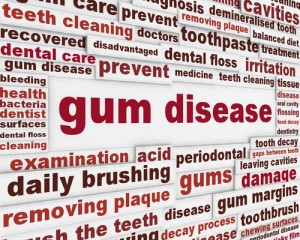 Gum disease – or periodontitis – is an infection caused by bacteria in your mouth. Often, the best “treatment” is to avoid the infection altogether with preventive dentistry. However, that’s not as easy as it sounds, so the next best thing you can do is to catch the infection as early as possible. In its early stages (known as gingivitis), gum disease can actually be reversed if caught soon enough. If left untreated, gum disease can progress and spread to your surrounding teeth and gum tissue. Unfortunately, in severe cases, teeth can be lost to the infection. So how can we stop gum disease in its tracks?
Gum disease – or periodontitis – is an infection caused by bacteria in your mouth. Often, the best “treatment” is to avoid the infection altogether with preventive dentistry. However, that’s not as easy as it sounds, so the next best thing you can do is to catch the infection as early as possible. In its early stages (known as gingivitis), gum disease can actually be reversed if caught soon enough. If left untreated, gum disease can progress and spread to your surrounding teeth and gum tissue. Unfortunately, in severe cases, teeth can be lost to the infection. So how can we stop gum disease in its tracks?
Gum Disease Treatment Options
Along with practicing preventive dentistry to avoid as much bacteria as possible, your dentist may recommend different treatments for your infection depending on the severity of your condition.
Deep Cleaning – Known as scaling and root planing, this deep cleaning method of treatment is commonly used to help control the infection. Your dentist will scrape the tartar and plaque from your teeth (above and below your gum line) as well as targeting spots on the tooth’s roots where bacteria has accumulated.
Medications – In some cases, different antibiotic medications may be encouraged to use alongside a deep cleaning. There are oral antibiotics that can help, but usually a gel or prescription mouthwash are preferred.
Oral Surgery – In extremely severe cases where the infection has compromised your gum tissue or jawbone, your dentist may recommend oral surgeries such as bone and gum tissue grafts to rebuild your mouth from the damage. If you’ve lost any teeth to the infection and are looking at your restoration options, dental implants require healthy gum tissue and adequate bone density so these surgeries are only preparing you to have your full functionality back sooner rather than later.
If you’re showing any symptoms of gum disease, don’t hesitate to make an appointment with your dentist. Don’t forget the earlier you’re able to catch it, the easier it is to treat!



